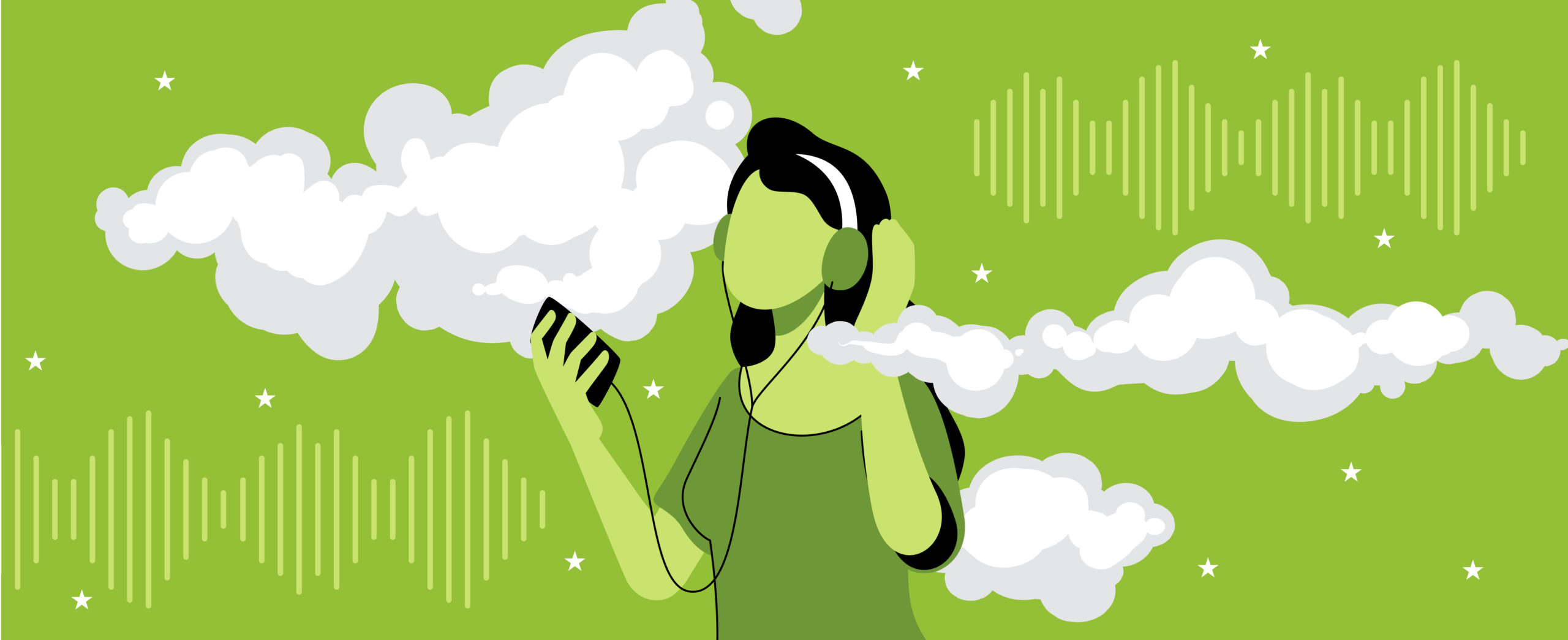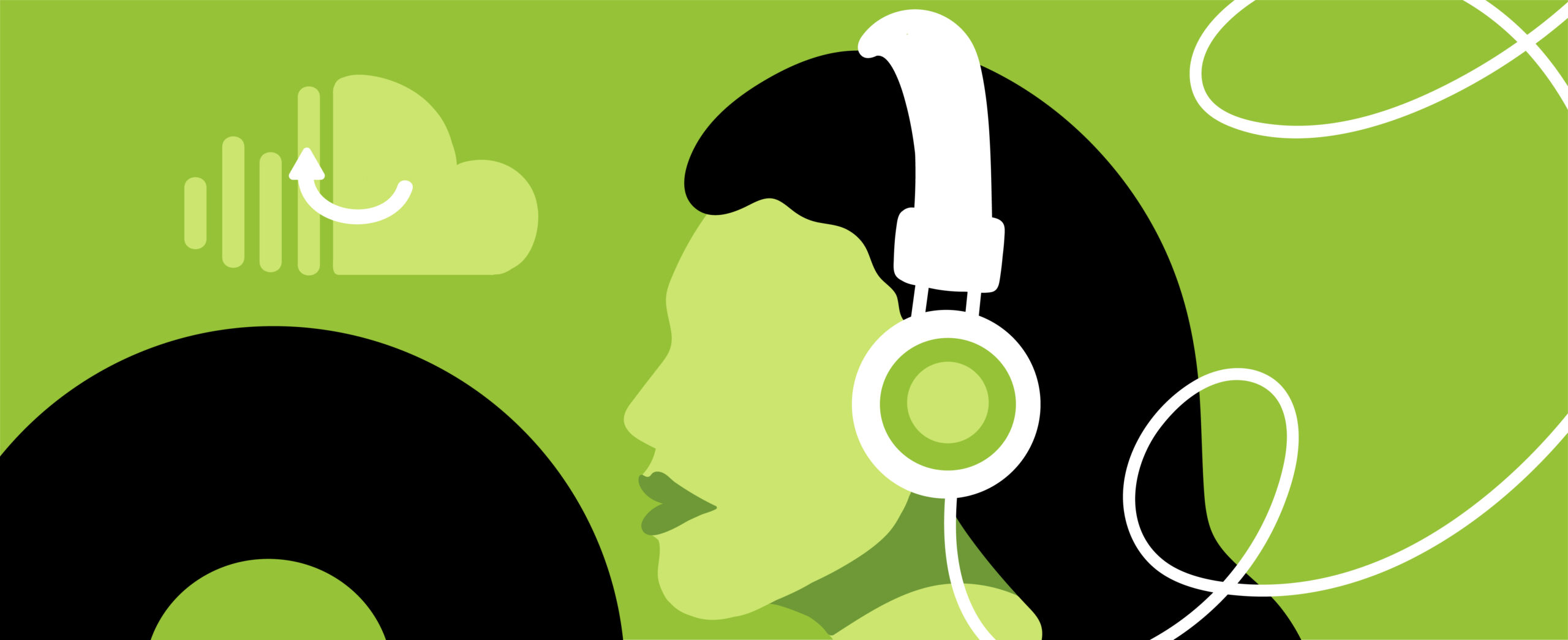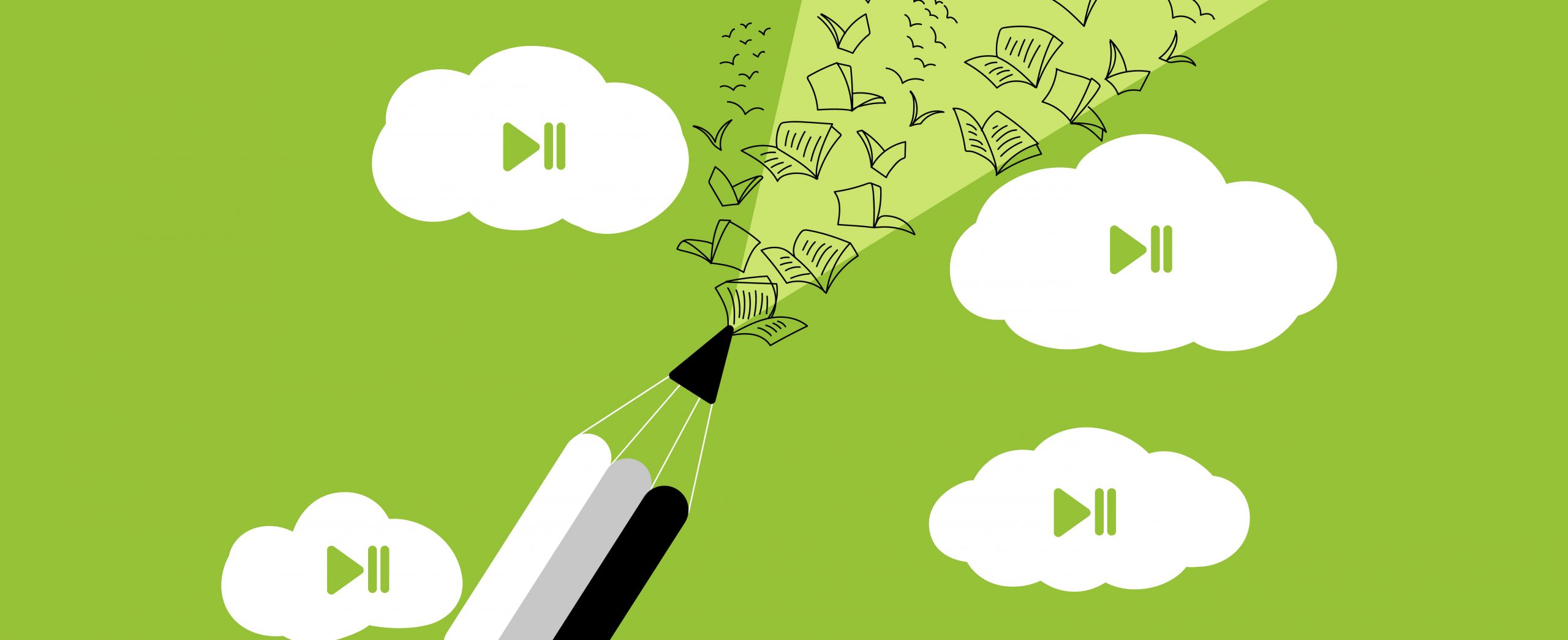
Of Whispering Machines and Talking Hats
How the digital revolution has transformed the lives of those living with blindness and impaired vision
For Leanne Duggan and Tim Noonan, the ‘overnight success’ of the audiobook industry has been decades in the making. And for these two Sydneysiders – blind since birth – it couldn’t have come sooner.
‘We’re so thrilled that talking books have become mainstream!’ Tim enthuses.
‘It’s certainly changed for the better,’ agrees Leanne. ‘The material that’s being recorded … there’s so much more variety these days. And the technological developments have completely changed the landscape for us.’
The brave new world of downloadable digital files has been nothing short of revolutionary for the blind and vision-impaired community.
‘Well, I don’t think it’s any great secret that Leanne and I are both in our fifties,’ Tim explains. ‘So we both remember the ‘60s, when we used to have five-kilo talking-book players which we couldn’t take anywhere with us. And they’d chew through the batteries like you wouldn’t believe!’
‘These days,’ says Leanne, ‘we just read on our phones like everybody else – that in itself is really amazing.’
The past decade has seen phenomenal growth in audiobook sales and consumption, and fuelled a demand-driven boom which is a game-changer for the industry. For blind people like Leanne and Tim, this has meant the dawn of a golden age in terms of choice and access, with some benefits that might surprise those of us who take for granted the ability to read a printed book.
‘It’s not something most sighted people think about,’ Tim confides. ‘But one of the worst things for me, growing up, came from the fact that talking books were generally produced by charities and recorded by volunteers. So many of the books were pushing a very conservative, Christian message. And, of course, it was incredibly censored. There was absolutely nothing spicy left in. Or – worst of all – you’d have a very well-meaning 70-year-old volunteer reading a book with a bit of erotic stuff in it … oh, it was excruciating.’
Leanne laughs. ‘You could hear in their voice how aghast they were to be reading this risqué passage. And the volunteers were such wonderful people – and incredibly generous with their time. So the thought they had to go through this for us … Oh, it was terrible. Took all the fun out of it.’
‘And that would trigger your own internalised shame, so you couldn’t enjoy the exciting parts,’ says Tim.
For a young Tim Noonan, these limitations came with additional burdens. ‘Being a young gay man, there was no content at all of male-male anything. So, I’d know there was material out there, but none of it was accessible to me. It was yet another way I felt marginalised. Young gay people learnt what was going on through gay magazines and publications. But none of that was available to blind men like me.’
Tim couldn’t be happier that things are changing . ‘These days – well it’s such a wonderful time to be alive!’ he says. ‘No matter how many different groups you identify with, there’s something for everyone!’
Until relatively recently, most of the people listening to audiobooks were, like Leanne and Tim, blind or vision impaired. Today, it’s estimated that there are 7.7 million Americans aged 16 or older who have a visual disability, while just over 450,000 Australians fall into that category. Those numbers weren’t high enough to attract serious commercial interest, which meant charitable institutions had to step in to provide the service to those who desperately needed it.
The charities catering to the blind community began with a mandate that all recorded books should be instructional and inspirational. So at first, very little fiction was recorded. Books were chosen because they were deemed to be ‘good’ for the people reading them, with many blind readers complaining of censorship when it came to titles containing sex, violence or profanity. Even classics such as Muriel Spark’s The Prime of Miss Jean Brodie were deemed too saucy to record.
That meant blind people were excluded from accessing the same reading material as their sighted peers. ‘When I was in my 20s and 30s, someone would tell me about a great new book, and I’d think, “Wow, that sounds fantastic!”’ Tim says. ‘But of course, I couldn’t read it. And when the talking book version was finally released – and that was always months, if not years, after the print version came out – more often than not it would be automated e-text, which was like having your GPS read you a book.’
‘I don’t think the average sighted person knows what it means to be able to go into a shop and buy a book,’ says Leanne. ‘We’ve never been able to go into a newsagent and just buy the paper or a magazine. So for us – for blind and vision-impaired people – it’s a monumental shift. It’s difficult to describe just how much these changes mean to people like me.’
Tim agrees. ‘You can’t even browse in a bookshop. I’d go into a bookshop with a friend, and I’d pull a book that felt nice off the shelf and say, ‘What’s this one about?’ We judge books by their covers every day … literally! People often think blind people like rough textures, but what we really love are smooth surfaces. Embossing is also great, as long as it’s in upper-case, because I’m terrible at reading lower-case!’
As an inquisitive child, Tim struggled to satisfy his curiosity about the world. ‘It wasn’t really until I was twenty or so that I had access to sources of information about the things I wanted to know,’ he says. ‘I feel like I squandered so many years because there was so little available to me. I’m sure it affected my cognitive development.’
As an adult, Tim was determined to help others overcome those same hurdles. Working with Vision Australia, he developed a service called Today’s News Now (TNN), which provided text-based audio articles read from newspapers all around Australia and available by phone on the day they were published.
Although it’s now been superseded by online services, Leanne remembers TNN fondly. ‘That was the first time I could independently access the newspaper. Until then, I had no idea there were things like opinion pages, and book reviews. I’m a huge foodie, and until TNN, I didn’t even know there were food pages in the paper. It was a fabulous service.’
For much of the twentieth century, talking books were seen as the exclusive domain of blind people. Although that perception has been shattered in recent decades, it’s ironic that when the chimerical dream of a talking book was first conceived, it was never imagined as a format for blind readers alone.
If Cyrano de Bergerac’s name is familiar to you, it’s probably as the titular hero of Edmond Rostand’s 1897 play, a character whose prodigiously large nose and prowess as a lover were immortalised in filmic form by Steve Martin and Gerard Depardieu. But in his lifetime, de Bergerac was a renowned dramatist who, in 1649, wrote one of the earliest works of science fiction. In Histoire Comique en Voyage Dans la Lune, de Bergerac wrote of a rocket trip to the moon where a human encounters alien technology, including ‘a Book made wholly for the Ears, and not the Eyes’.
‘When anybody has a mind to read,’ de Bergerac wrote, ‘he winds up that machine with a great many strings; then he turns the hand to the chapter which he desires to hear, and straight, as from the mouth of a man, or a musical instrument, proceed all the distinct and different sounds … the young men of that country were more knowing at sixteen- or eighteen-years-old, than the greybeards of our climate; for knowing how to read as soon as speak, they are never without lectures … they may have in their pockets … thirty of these books.’
In his far-reaching historical survey of the audiobook industry, The Untold Story of the Talking Book, academic Matthew Rubery identifies the spiritual father of the audiobook as that most prolific of inventors, Thomas Edison.
In a letter published in the Scientific American in 1877, Edison announced his plans to mechanically reproduce the human voice. Just three weeks later, he recorded himself reciting Mary Had a Little Lamb. This was, of course, the technology that spawned the phonograph. As he devised grand plans to record books, Edison was not catering to the blind. He imagined audiobooks as technology for all.
‘Say I hire a good elocutionist to read David Copperfield,’ he said. ‘His words are taken down by machine, and thousands of matrixes of David Copperfield produced. A man can place them in the machine, and lie in bed, while the novel is read to him by the instrument … He can make it read slow or fast, can stop it when he pleases, and go back and begin again at any chapter he may choose.’
Edison’s vision was polarising. While one beguiled, and prescient, journalist declared that ‘the library of the future will be one which any man can carry under his arm,’ others were less enthusiastic. In 1877, a writer in the New York Times warned, ‘If the phonograph proves to be what its inventor claims it is, both book-making and reading will fall into disuse.’
Despite attempts to preserve Charles Dickens’ novels on his wax cylinders, Edison was 150 years ahead of his time, and never managed to publish a single book. But he had sparked an idea that would evolve into the audiobook we know today.
Others took Edison’s idea and ran with it – with varying degrees of success. In 1883 at the University of Minnesota, Professor Evert Nymanover devised a novel approach (pardon the pun). In a submission to Scientific American, he proposed replacing printed books with what he called ‘whispering machines’ to be installed in people’s hats.
‘Everyone while sitting in cars, walking in the streets, reclining on beds and sofas, could be perpetually listening to Adam Smith’s moral sentiments,’ he wrote, ‘and yet be at the same time talking, resting, working at a carpenter’s bench, dressing, promenading, practicing finger-exercises on the piano, or other instruments.’
But it wasn’t until the first decades of the twentieth centuries that talking books became a reality. To cater to World War I veterans blinded by chemical warfare, so-called ‘talking books for the blind’ were sponsored in the US by the American Foundation for the Blind, and by the Royal National Institute of Blind People in Great Britain.
The first full-length audio book was a 1935 recording of Joseph Conrad’s 1902 novella, Typhoon. It joined jingoistic spoken-word documents including the Declaration of Independence and Lincoln’s Second Inaugural Address. Despite the ponderous material, it was a godsend to injured soldiers who had lost their sight and had never learnt to read braille.
Even to people like Leanne and Tim who are literate in braille, books printed in the tactile alphabet come with their own challenges. ‘You only get 200 words a page with braille books,’ explains Leanne. ‘Whereas you get 500 on a typewritten page. So the braille volumes are enormous. You can’t just pop them in your pocket and take them on the train with you.’
‘And braille is such an active way of reading. I know this is going to sound strange, but reading braille really makes your arms sore!’ says Tim.
‘You’re so right!’ Leanne agrees. ‘And then there’s winter – the thing with braille books is that your arms are above the doona, and it gets cold! With an audiobook, I can snuggle down under the covers with the speaker near my ear and be cosy and warm!’
The advent of digital audiobooks has been a life-changing experience for Tim and Leanne. ‘The fact I can leave the house to walk the dog with my partner, and have three or four books I can listen to while we sit in the park, well, that’s the sort of thing that excites me,’ says Tim.
Leanne sees other, more far-reaching benefits. ‘I think there’s a very important social aspect to it as well, because it means vision impaired people can join book clubs to discuss a current book that everyone’s reading. It sounds strange, but that was never available to us.’
As a senior caseworker on the NSW Domestic Violence Crisis Line, for Leanne, audiobooks also offer a sanctuary. ‘There’s no doubt at all that they’re extremely helpful for my mental health. I work full-time in a really stressful job,’ she says. ‘So I just want something I can relax into so I can settle in at the end of the day and switch off.’
Like Tim, who is a professional voice counsellor and coach, Leanne’s hyperdeveloped listening skills come to the fore in her work. ‘All our work is by phone,’ she explains. ‘A lot of that is risk assessment – and I’d say that my blindness does give me an advantage, because while other people are busy looking at their computer screens, I’m dedicating myself 100 per cent to listening.’
Those refined listening skills mean blind readers of audiobooks are particularly attuned to the authenticity of the story they’re hearing. There’s no pulling the wool over eyes that cannot see. ‘It’s one thing for actors to play a role,’ says Leanne. ‘But I think it’s so important for narrators to empathise with the story, and really relate to the characters on a personal level. Otherwise it just doesn’t feel authentic.’
Tim agrees. ‘As blind people, we’re expert at picking inauthenticity. For audiobooks, that means we can identify inauthentic narrators. And it’s great now because there are so many books dealing with gender issues that are narrated by people who are queer, or trans – people who understand the experiences the author is writing about. So you really feel comfortable while you’re listening to those stories.’
It’s been said that blind people see with their minds. Research suggests that listening to an audiobook does the same thing for sighted readers, and is one of the reasons it’s much easier to understand Shakespeare performed live than it is to read his plays. The act of reading symbols on a printed page triggers our over-taxed visual cortex to produce vivid, and often distracting, word associations that can dilute the meaning of the words we’re attempting to absorb.
Like so many other staunch advocates for audiobooks, Leanne and Tim want to see the end of the lingering bias against the medium, which Rubery describes as ‘one of the few forms of reading for which people apologise.’ It’s a mindset that’s no doubt spawned by the post-Enlightenment western attitude that equates illiteracy with ignorance and poor education.
‘The idea that if you listen to a book, you’re not a reader … that’s complete nonsense,’ says Tim.
‘We also need to think about it in terms of literacy,’ Leanne adds. ‘I’m hoping the stigma around audio is going to go away because it’s so unhelpful, and audiobooks bring so much to so many people.’
In the meantime, Leanne and Tim are both excited by a future where the audiobook industry continues to thrive. ‘My job at home is to choose which books my husband will enjoy reading, which I love doing,’ says Tim. ‘Nowadays, there’s no limits at all! But it does mean I consume an unhealthy number of books!’
‘Unhealthy number of books? There’s no such thing!’ Leanne laughs. ‘For me, it’s all the small things I can do now that I couldn’t before. When I’m babysitting my friends’ children, for instance, I can listen to an audiobook with them when I tuck them up in bed at night. That’s something I couldn’t do before. And they’re memories I’ll cherish for the rest of my life.’
Written by – https://meaghanwilsonanastasios.com/



